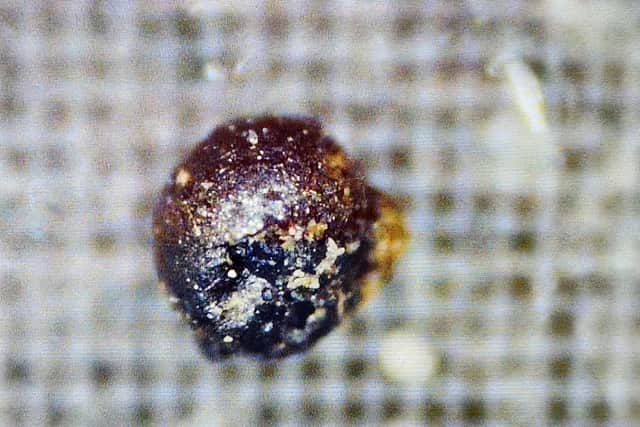Alien objects on Earth: Harvard physicist says metal fragments from expedition come from outside solar system
and live on Freeview channel 276
A Harvard University astrophysicist believes he has found proof of alien life at the bottom of the Pacific Ocean.
On his Medium blog, Dr Avi Loeb claims his team have recovered material that originated outside the solar system.
Advertisement
Hide AdAdvertisement
Hide AdFrom the 700 spheres collected and analysed, none of the alloys match any existing alloys in the solar system. However, the findings do not yet answer whether the spheres are artificial or natural in origin.


"This is a historic discovery because it represents the first time that humans put their hand on materials from a large object that arrived on Earth from outside the solar system", Loeb wrote Tuesday (29 August) on Medium.
The composition analysis of the spherules was performed by Stein Jacobsen and his cosmochemistry laboratory team at Harvard University.
Loeb told DailyMail.com: "I was thrilled when Stein Jacobsen reported to me about it based on the results in his laboratory. Stein is a highly conservative and professional geochemist with a worldwide reputation.
Advertisement
Hide AdAdvertisement
Hide Ad"He had no bias or agenda whatsoever and expected to find familiar spherules with solar system composition. But the data showed something new, never reported in the scientific literature. Science is guided by evidence."
Dr. Avi Loeb completed a $1.5m expedition looking for signs of a meteor, named IM1, that crashed off the coast of Papua New Guinea in 2014. It is believed IM1 came from interstellar space.
Professor Loeb said early analysis of the metal fragments his team recovered in June of this year, are about half a millimetre in size and are most likely made from a steel-titanium alloy that is much stronger than the iron found in regular meteors.
The tiny spherules, or molten droplets, were found using a magnetic sled dropped from the expedition vessel the Silver Star 2km underneath the surface of the ocean.
Advertisement
Hide AdAdvertisement
Hide AdIM1 withstood four times the pressure that would typically destroy an ordinary iron-metal meteor — as it hurtled through Earth's atmosphere at 100,215 miles per hour.
Also known as CNEOS1 2014-01-08, the object had an estimated diameter of 1.5 feet, a mass of 1,014 pounds and a pre-impact velocity of 37.3 miles per second.
He told The Independent, that IM1 caught the attention of his research team after they combed NASA’s open-source catalogue of meteors for irregular space rock detected around the Earth.
The meteor stood out due to its high velocity, as it travelled faster than 95% of nearby stars, and the fact it had exploded much lower in the Earth’s atmosphere than most meteors.
Advertisement
Hide AdAdvertisement
Hide AdHe told The Independent: "The object was tougher than all (272) other space rocks recorded in the same NASA catalogue, it was an outlier of material strength."
He and his Harvard colleague Amir Siraj calculated with 99.999% confidence that IM1 had travelled to Earth from another star.
At first, this paper was rejected, but in April 2022, the chief scientist of the US Space Operations Command confirmed IM1’s velocity.
Through using a combination of Department of Defense data and seismology readings, Prof Loeb could calculate where debris from IM1 had roughly fallen - which enabled him to make a path.
Advertisement
Hide AdAdvertisement
Hide Ad“It’s easier to seek extraterrestrial facts on the Pacific Ocean floor than get them from the government,” Prof Loeb wrote in an expedition journal on Medium at the time.
On 14 June, the Silver Star vessel set out 84km north of Manus Island, Papua New Guinea - where it was estimated IM1 landed.
The crew then dropped a meter-wide magnetic sled into the ocean and began collecting control samples of volcanic ash from the ocean.
Around one week into the expedition, a sled picked up the first “spherical metallic marbles”.
Advertisement
Hide AdAdvertisement
Hide AdThe spherules are formed as meteors and asteroids explode and have been found at impact sites across the globe. The “tiny metallic pearls” were so small they were difficult to pick up with tweezers, Prof Loeb said.
The professor said the material initially looked like shards of corroded iron, but after examining them under fluorescent X-Ray, the research team determined they were most likely a steel and titanium alloy, also known as S5 or shock-resisting steel. The strength of S5 steel is well above that of iron meteorites, Prof Loeb wrote on Medium.
The objects were taken to Harvard College Observatory, where a team of researchers analysed them for comparisons to other meteorite debris.
Prof. Loeb chaired Harvard’s Astronomy Department from 2011 to 2020. He now leads the university’s Galileo Project, which is establishing open-sourced observatories across the world to search for signs of UFOs and interstellar objects.
Comment Guidelines
National World encourages reader discussion on our stories. User feedback, insights and back-and-forth exchanges add a rich layer of context to reporting. Please review our Community Guidelines before commenting.
